Can’t afford to solve one problem at a time
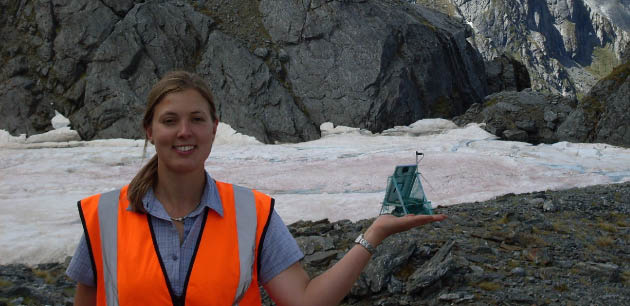
Alpine Quake Whisperer: Monitoring thousands of earthquakes under the Southern Alps too slow and too small to feel, Dr Carolin Boese et al., when they published last year, were yet to determine whether the activity is adding to or relieving Alpine Fault stress that, based on its almost-clockwork behaviour over 8000 years, has a 30% probability of rupturing during the next 50. image School of Geography, Environment and Earth Sciences, Victoria University of Wellington
When the Alpine Fault goes, it will probably take Wellington with it.
Wellington, now Aotearoa’s second largest city, is staring down the barrel of the Alpine Fault, which is primed and due to jump eight metres horizontally and four vertically. In both 1220 and 1450, there were near-synchronous ruptures of the Alpine and Wellington faults.
The Alpine Fault rupture will release 30 times more energy than did the September 2010 Darfield Earthquake, and up to 1000 times more energy than one that devastated central Christchurch nearly six months later. Christchurch may initially pass relatively unscathed thanks both to its 120-kilometre distance from the fault line and the replacement of its more earthquake-vulnerable buildings, but its barely-above-sea-level rebuild leaves the city vulnerable to tsunami. Involving strike-slip faults, however, ‘the big one’ is unlikely to produce the likes of the 30-metre 15th century tsunami that is hypothesised to have had a hand in resetting Māori culture. Like earthquakes, tsunami are not a matter of if but when, and if anything, the taniwha will strike with increasing viciousness.

Straight as a Gun Barrel: When it ruptures, the Alpine Fault will release up to 1000 times more energy than the earthquake that so devastated central Christchurch on Tuesday 22 February 2011. image National Aeronautics and Space Administration
Ever rising, the cost of rebuilding Christchurch is currently estimated at $40 billion. If the inevitable Alpine Fault rupture triggers the Wellington Fault, which runs clear through to the Bay of Plenty, the costs, as well as the magnitude, would be catastrophic. But while earthquakes can’t be prevented, they can be planned for, as can sea-level rise. Even in the unlikely event that carbon dioxide failed to rise substantially above its recent milestone of 400 parts per million, sea level, in time, would stabilise some 40 metres higher than today’s. The question that challenges glaciologists is not how high oceans will rise, but how quickly. Until recently, glaciologists were generally adamant that it would take centuries, if not millennia, for the new temperatures to translate into sea level rise—very big blocks of ice were calculated to melt very slowly. However, inland regions of Greenland’s glaciers have now been found to be flowing one and a half times faster within a seven-year period. The reason for this unanticipated acceleration is the combined softening and lubricating of glaciers riddled with deep-draining sun-warmed surface meltwater:
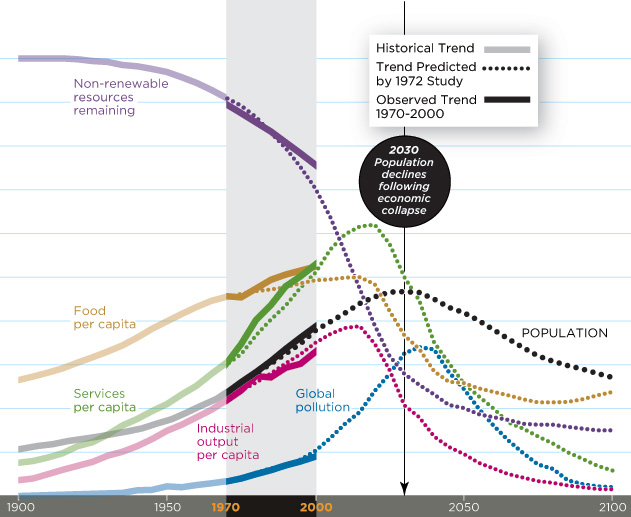
Bang on Target: Despite millions of words denouncing its projections since, the Club of Rome’s Limits to Growth projections of 1972 were unerringly accurate. chart Smithsonian Magazine
The chunk of butter known as the Greenland Ice Sheet may be softening a lot faster than we previously thought possible.
It is to be hoped that the turning point for large-scale climate action is provided by other than sea-level rise. This is because sea-level rise is unlikely to be linear, and the rate for the next decade, at first blush, will not appear too alarming—not a great deal more than the current 3.3 millimetres per year, give or take. However, satellite measurements show the rate of ice loss from Greenland and Antarctica almost doubling since 2002. If the doubling period proves to be seven years, by 2055 sea level will be one metre higher, and by 2071, five metres. Meantime, many local councils are still only planning for half a metre by 2100, the National-led government having, North Carolina style, axed work on a national guideline.
So while sea-level rise will eventually provide the sort of certainty that would give politicians the backbone to act on global warming, the scope of the global climate emergency will by then have outstripped governments’ abilities to safeguard their populations. Devastation from the unfolding impacts of anthropogenic global warming will make Aotearoa’s earthquakes appear trifling, for rather than an enervating but diminishing series of aftershocks, global warming visitations, on average, will progressively increase in severity: On the coast, larger storm surges, on bigger tides, on higher sea levels. In dry areas, more frequent, hotter and longer droughts. In wetter areas, more frequent and more destructive downpours, and larger landslides. Continually soaring food prices, sparking ever increasing popular revolts, accelerating the retreat of democracy.
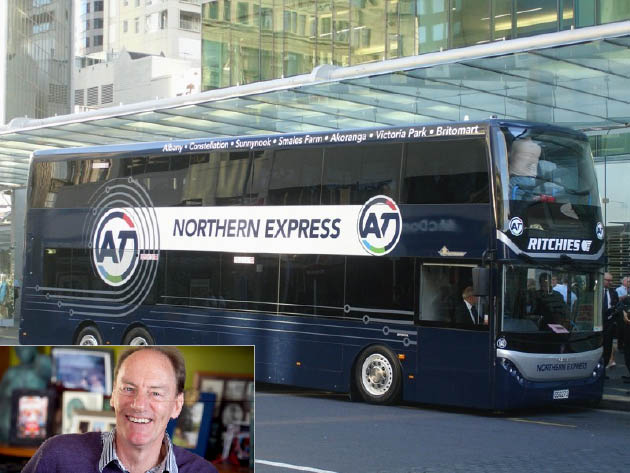
Fareless: Aucklanders have the choice of more government spending on motorways and the future prospect of rail-for-asset-sales, as per the Mayor Brown Faustian bargain, or John Minto’s courageous ‘free and frequent’ buses. No transportation is free, but the National Party’s abuser-pays plan is for future generations to pay for both the roading infrastructure and with their lives as fossil-fuel use condemns them to a hellish climate and rapidly rising sea levels. image Ritchies Transport Urban Services Insert image Natalie Slade
With the onset of widespread famine and other heat-related horrors almost too gruesome to contemplate, the scene is set for the complete unravelling of global civilisation. Some claim, with some justification, that the 40-year failure of governments to acknowledge the limits to growth and to curb the of plague of people that is responsible for humanity’s suicidal trajectory is conclusive proof that decisive action to end fossil fuel use and reduce population will not occur. But an absence of evidence of past climate action is not evidence for the absence of action in the future. That would be akin to saying that because Winston Churchill wasn’t heeded prior to the invasion of Poland, the United Kingdom wouldn’t respond when Poland was invaded, and that the world is now under the heel of the Third Reich.
It is true that the fossil-fuel oligarchy owns many politicians and political parties, and most of the mainstream media. It is also true that by blindly pursuing growth for the last four decades, many more are now in harm’s way, and the casualties will likely greatly exceed those of both world wars and the flu pandemic that followed the first. But a mobilisation will occur, once an overrun and overheated planet provides the 21st century with an unequivocal Poland or Pearl Harbour.
Hurricane Sandy and the Midwest and Great Plains Drought, costing a combined US$100 billion, have been sufficient for some Americans to speak out, pivotally President Barack Obama. Heat waves hammering the northern hemisphere are convincing millions and killing others. Although only nine deaths have been recorded in New York city recently, with one victim as young as 61, the actual toll is typically not learned until well after a heat wave event. That is possibly why 70 000 could expire during the 2003 European heat wave without the scale of the deaths provoking immediate and sustained climate action.
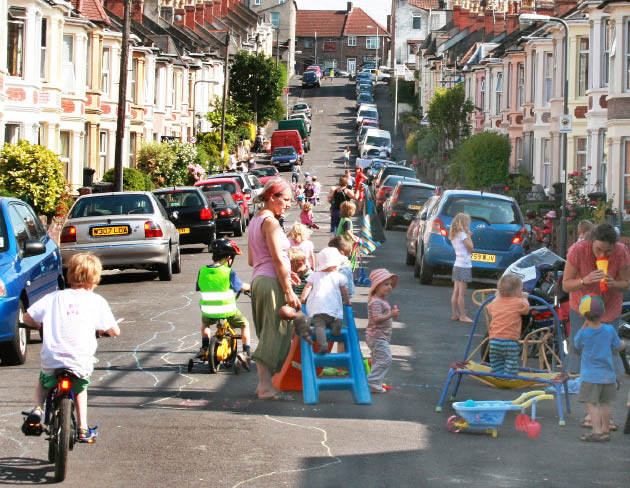
Climate Action Bristol Fashion: Bristol City Council is leading the way in supporting street play by readily issuing temporary play street orders in a bid to encourage more children to play outside their homes. Not only is this just what the epidemiologist ordered to radically reduce the incidence of non-communicable diseases, it encourages public transport over private car use, which is worth more than all the photovoltaic panels in China. image Bristol City Council
The challenge of radically reducing fossil-fuel use cannot begin to be met by buying electric cars and installing photovoltaic panels. While photovoltaic has its place, such as providing lighting and cell phone charging for unreticulated Pacific communities, it hasn’t a hope of powering electric commuter trains, or trolleybuses. Only John Minto, of Auckland’s mayoral candidates, has a policy that would make a meaningful contribution to reducing fossil fuel use—the provision of free and frequent buses. The Northern Busway has demonstrated that Aucklanders will flock to buses, where the alternative is to inch, one-car-per-person, along an imperceptively moving motorway. The Northern Busway effect can readily be rolled out throughout the city, with busways, and traffic lights prioritising them. The notion of decongesting Auckland, by building more roads as per Mayor Len Brown and the National Party plan is fanciful. But in addition to replacing cars with buses, much smarter use of fibre-optic cabling is needed. Although much more cost-effective than private cars and car parks, nor is public transport inexpensive—Minto estimates free public transport would cost an additional $680 million per year, including $400 million to double the number of buses. A major reason for the high cost of transport is that the system has to facilitate a vast majority of journeys taking place within an hour or so at either end of the working day. Under a free public transport regime, an organisation prepared to deviate from the norm of requiring its employees to work onsite from eight- or nine-to-five is not directly rewarded for reducing its demands on the city’s transport infrastructure. But charging passengers, either manually or electronically, during peak times may not be the answer—the less time buses are stationary, the better for all concerned. The hardnosed option might be to charge electronically only, and exclude all others, including those tendering SuperGold cards, during peak hours. In any event, radical action is called for to end the dominance of the private car, and free and frequent buses would be a robust first step.
With global warming the defining moral issue of the 21st century, and the 22nd if humanity is spared, it is instructive that the closest an Auckland mayoral candidate has come to mentioning it is Minto, but only in passing and not in writing, as an additional benefit from free and frequent public transport. But this, and the appeal of spending an extra hour a day with family, is to significantly undersell its advantages. On Wednesday at Massey University’s Albany campus, Professor Neil Pearce, visiting from the London School of Hygiene and Tropical Medicine, lectured on preventing non-communicable diseases through low-carbon development. In short, measures such as education aimed at persuading populations to quit smoking, exercise more, and to take less salt and alcohol have been found to have negligible effect. What does work, however, is redesigning communities to minimise time spent in cars. The benefits extend not just to those who walk or cycle to work, but to those using public transport, on account of that wee extra bit of walking that goes with it.
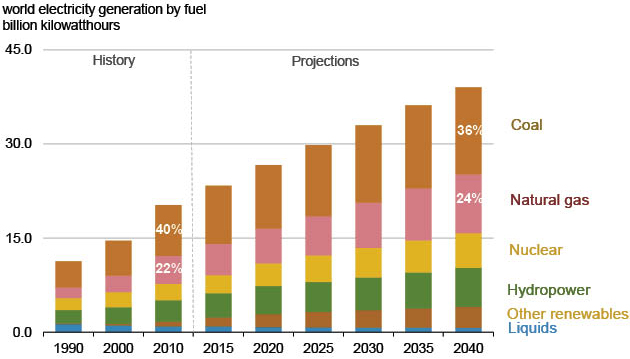
Fossil-Fueled Future: While much is made of recent increases in the use of wind and solar energy, they build from a miniscule base, once hydropower is extracted. Overall, fossil fuels will continue to dominate the future, and with disastrous consequences unless control is quickly wrested from the hands of the fossil fuel oligarchy, which in turn can only be achieved through comprehensive campaign finance reform. chart US Energy Information Administration, International Energy Outlook 2013
For a world-leading epidemiologist to discover that a fossil-fueled lifestyle is the root cause of many non-communicable diseases, and that the most cost-effective solution is also the most climate-effective one, is a revelation that has broad application. Rebuilding back from the coast on higher ground is necessitated by sea-level rise, but it has the short-term benefit of practically eliminating tsunami exposure, and it provides opportunity natural healthy recreation—even as it is ravaged by sea-level rise, the coastline will hold its fascination.
Tellingly, the aspect of the pre-draft unitary plan that has most unsettled Aucklanders is its provision for their number to swell by a million over the next 30 years. However, in their election statements to the New Zealand Herald, only Penny Bright, whose last mayoral foray netted about half of one percent of the vote, has questioned the plan’s growth assumptions. A human population possibly already six times its sustainable level is the root cause of global warming and species extinction, at a rate reported to be running at 100–1000 times (and headed towards 10 000 times) the background level. Yet no political party dares speak of it. A virtual breeding moratorium is the only realistic and humane means of navigating the existential canyon that is rapidly closing in on species, not least of all Homo sapiens sapiensas opposed to Homo sapiens, to acknowledge Homo sapiens idaltu, and to avoid the more cumbersome alternative of ‘anatomically modern human being’, and for sheer cussedness.
While all may appear hopeless to those who comprehended the limits of growth 40 years ago, only to have witnessed nothing but growth-for-growth’s-sake since, 80% of under-35-year-old voters just surveyed support President Obama’s climate action plan and three-quarters regard Republican denialist candidates as ‘ignorant’, ‘out of touch’ or ‘crazy’.
It probably won’t be Obama, but sooner or later a world political leader will state the breeding obvious: There is a global-crises silver bullet; a rubber one.
